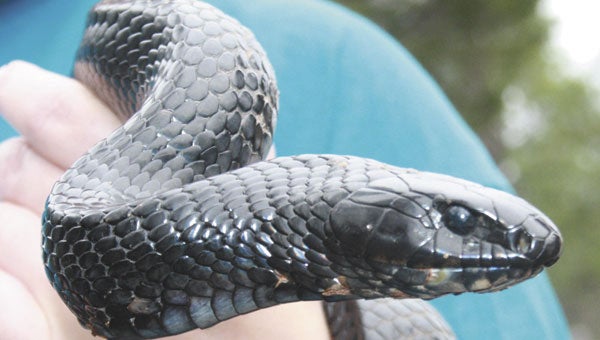Goodness SNAKES!
Published 12:55 am Wednesday, February 6, 2013
Sierra Stiles thinks nothing of handling the animal most are taught from infancy to fear – the snake.
But, this wasn’t any ordinary – or venomous – snake. It was special, said a group of U.S. Forest Service employees and Auburn University biologists Tuesday – it was proof that a 2010 project to repopulate the Conecuh National Forest with the endangered Eastern Indigo snake is working.
That Wednesday in June two years ago marked the first time in 50 years the snake could be found in the forest. Then, 18 juvenile snakes were released in what Alabama Division of Wildlife and Freshwater Fisheries biologists hoped was a new start for the snakes’ survival in the state. Nine were placed in fenced habitats; the other nine were released into the wild.
Hatched inside a lab in 2008, each snake was implanted with a passive integrated transponder, or PIT tag, for tracking, and an identification device, all of which will be monitored by Auburn University to determine which habitat is better suited for the species’ survival. In doing research Sunday, Jimmy and Sierra Stiles located a pair of Indigo snakes and discovered something wonderful, they said.
“Right now is mating season,” Mrs. Stiles said. “The male had a transmitter; the female did not. What we can figure is the male was chasing the female. It was amazing we found her. We were able to track her number, which showed she was one of the first ones released.”
Since then, the couple has studied the snake, which measured just over 6-foot and weighed 5 pounds.
Yesterday, the female got her new home – a gopher tortoise burrow in the Conecuh.
“This is just an amazing process,” said CNF biologist Dr. Mark Garner.
Historically, the Eastern indigo snake lived throughout Florida, the coastal plain of southern Georgia, extreme south Alabama and extreme southeast Mississippi. Today, the indigo snake survives in peninsular Florida and southeast Georgia, and persists in the Florida panhandle in low numbers.
The slow growth of population by humans in the area, as well as timber harvesting, is credited with the snake’s demise. Before the re-population project, the last known sighting of the snake in the wild locally was in 1954, just north of Florala.
In 1978, the lustrous, glossy, blue-black, non-venomous snake was listed as “threatened” by the U.S. Fish and Wildlife Service under the Endangered Species Act. The Eastern Indigo snake is the longest snake in North American, reaching up to 8 ½ feet long and weighing up to 11 pounds.






